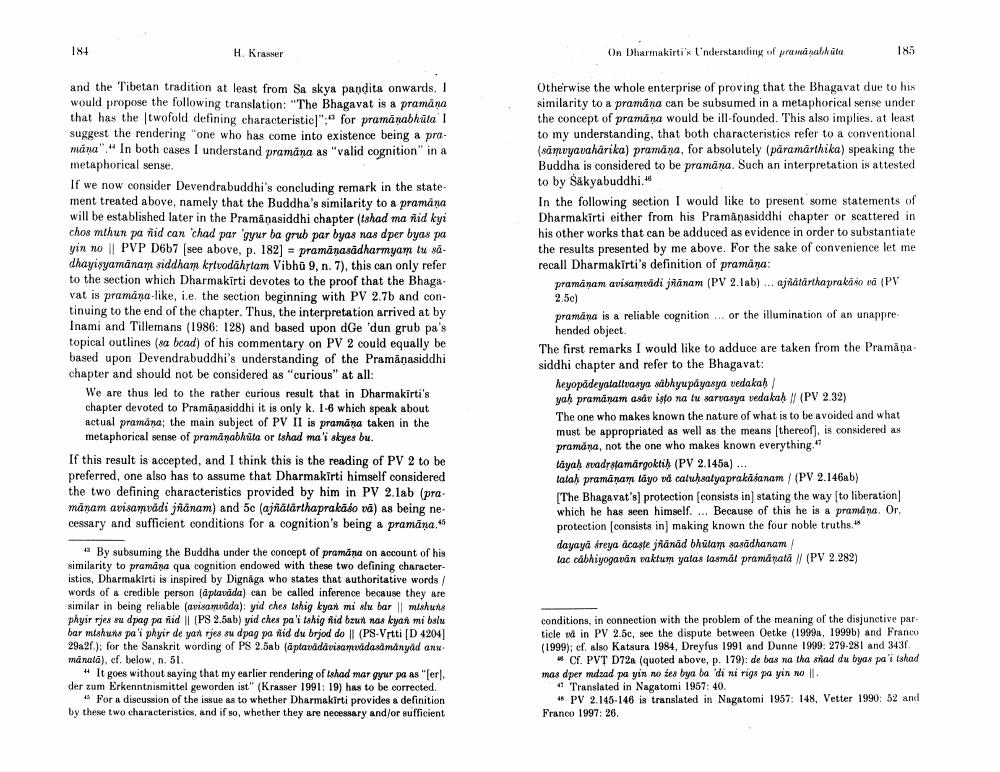Book Title: On Dharmakirtisunderstanding Of Pramanabhuta And His Definition Of Pramana Author(s): Helmut Krasser Publisher: Helmut Krasser View full book textPage 7
________________ 18+ H Kramer On Dharmakirtis nderstanding of pramānabküla 185 and the Tibetan tradition at least from Sa skya pandita onwards. I would propose the following translation: "The Bhagavat is a pramana that has the twofold defining characteristic]":" for pramanabhūla I suggest the rendering one who has come into existence being a pramana". In both cases I understand pramana as "valid cognition in a metaphorical sense If we now consider Devendrabuddhi's concluding remark in the statement treated above, namely that the Buddha's similarity to a pramana will be established later in the Pramanasiddhi chapter (tshad ma nid kyi chos mthun pa vid can 'chad par 'gyur ba grub par byas nas dper byas pa yin no || PVP D6b7 (see above, p. 182] = pramänasädharmyam tu sadhayisyamanam siddham kytvodāhrtam Vibha 9, n. 7), this can only refer to the section which Dharmakirti devotes to the proof that the Bhagavat is pramana-like, ie, the section beginning with PV 2.7b and continuing to the end of the chapter. Thus, the interpretation arrived at by Inami and Tillemans (1986: 128) and based upon dGe 'dun grub pa's topical outlines (sa bead) of his commentary on PV 2 could equally be based upon Devendrabuddhi's understanding of the Pramānasiddhi chapter and should not be considered as "curious" at all: We are thus led to the rather curious result that in Dharmakirti's chapter devoted to Pramāpasiddhi it is only k. 1-6 which speak about actual pramana; the main subject of PV II is pramana taken in the metaphorical sense of pramānabhila or Ishad mai skyes bu. If this result is accepted, and I think this is the reading of PV 2 to be preferred, one also has to assume that Dharmakirti himself considered the two defining characteristics provided by him in PV 2.lab (pramanam avisamvadi jñānam) and 5c (ajñālärthaprakaso vä) as being necessary and sufficient conditions for a cognition's being a pramana. Otherwise the whole enterprise of proving that the Bhagavat due to his similarity to a pramana can be subsumed in a metaphorical sense under the concept of pramana would be ill-founded. This also implies, at least to my understanding, that both characteristics refer to a conventional (sāmvyavahärika) pramana, for absolutely (paramarthika) speaking the Buddha is considered to be pramāna. Such an interpretation is attested to by Sakyabuddhi." In the following section I would like to present some statements of Dharmakirti either from his Pramanasiddhi chapter or scattered in his other works that can be adduced as evidence in order to substantiate the results presented by me above. For the sake of convenience let me recall Dharmakirti's definition of pramana: pramanam avisam vidi jñānam (PV 2.lab) ... ajratarthaprakso (PV 2.5c] pramana is a reliable cognition ... or the illumination of an unappre hended object. The first remarks I would like to adduce are taken from the Pramāna siddhi chapter and refer to the Bhagavat: heyopādeyalattvasya sübhyupāyasya vedakah / yah pramanam asáv isto na lu sarvasya vedakah // (PV 2.32) The one who makes known the nature of what is to be avoided and what must be appropriated as well as the means thereof), is considered as pramina, not the one who makes known everything." layah svadratamargoktih (PV 2.145a) ... tatah pramanam tayo vd caluhsatyaprakasanam / (PV 2.146ab) [The Bhagavat's) protection consists in stating the way to liberation which he has seen himself.... Because of this he is a pramana. Or, protection consists in) making known the four noble truths. dayayi dreya dcaste jñānād bhūtam sasādhanam lac cabhiyogawin waktum yalas lasmál pramanata // (PV 2.282) By subsuming the Buddha under the concept of pramana on account of his similarity to pramana qua cognition endowed with these two defining characteristics, Dharmakirti is inspired by Dignāga who states that authoritative words/ words of a credible person (áplavada) can be called inference because they are similar in being reliable (avisampida): yid ches Ishig kyani mi slu bar | mishuns phyir rjes su daug pa riid || (PS 2.5ab) yid ches pa'i fshig tid brun nas kyan mi balu bar mahune pa'i phyir de yan rjes su dpag pa niid du brjod do I (PS-Vrtti (D 4204] 29020); for the Sanskrit wording of PS 2.5ab laplavidavisamuddasd manyad ann. manala), cf. below, n. 51. - It goes without saying that my earlier rendering of Ishad mar gyur pa as "ferl. der zum Erkenntnismittel geworden ist" (Krasser 1991: 19) has to be corrected. 15 For a discussion of the issue as to whether Dharmakirti provides a definition by these two characteristics, and if so, whether they are necessary and/or sufficient conditions, in connection with the problem of the meaning of the disjunctive par ticle wi in PV 2.50, see the dispute between Oetke (1998, 1999b) and France (1999); cf. also Katsura 1984, Dreyfus 1991 and Dunne 1999: 279-281 and 343f - CE. PVT D720 (quoted above, p. 179): de bas na tha wilad du byas i Ishad mas dper mdaad pa yin no żes bya ba 'di ni rigs pa yin no 11. 11 Translated in Nagatomi 1957: 40. *PV 2.145-146 is translated in Nagatomi 1957: 148, Vetter 1990: 52 and Franco 1997: 26.Page Navigation
1 ... 5 6 7 8 9 10 11 12 13 14
